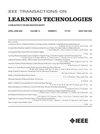Multimodality of AI for Education: Toward Artificial General Intelligence
IF 4.9
3区 教育学
Q2 COMPUTER SCIENCE, INTERDISCIPLINARY APPLICATIONS
引用次数: 0
Abstract
This article addresses the growing importance of understanding how multimodal artificial general intelligence (AGI) can be integrated into educational practices. We first reviewed the theoretical foundations of multimodality in human learning, encompassing its concept and history, dual coding theory and multimedia theory, VARK multimodality, and multimodal assessment (see Section II-A). After that, we revisited the essential components of AGI, particularly focusing on the multimodal nature of AGI that distinguished it from artificial narrow intelligence. Based on its conversational functionality, multimodal AGI is considered an educational agent already tested in various educational situations (see Section II-B). How significant text, image, audio, and video modalities are for education, the technological backgrounds of AGI for analyzing and generating them, and educational applications of artificial intelligence (AI) for each modality were thoroughly reviewed (Sections III–VI). Finally, we comprehensively investigated the ethics of AGI in education, originating from the ethics of AI and specified in three strands: first, data privacy and ethical integrity, second, explainability, transparency, and fairness, and third, responsibility and decision-making. Practical implementation of ethical AGI frameworks in education was reviewed (see Section VII). This article also discusses the implications for learning theories, derived operational design principles, current research gaps, practical constraints and institutional readiness, and future directions (see Section VIII). This exploration aims to provide an advanced understanding of the intersection between AI, multimodality, and education, setting a foundation for future research and development.教育领域人工智能的多模态:走向通用人工智能
本文阐述了理解如何将多模态通用人工智能(AGI)集成到教育实践中的重要性。我们首先回顾了人类学习中多模态的理论基础,包括它的概念和历史、双重编码理论和多媒体理论、VARK多模态和多模态评估(见第II-A节)。在那之后,我们重新审视了AGI的基本组成部分,特别关注AGI的多模态本质,这将其与人工狭义智能区分开来。基于其会话功能,多模态AGI被认为是一种已经在各种教育情境中测试过的教育代理(见第II-B节)。全面回顾了文本、图像、音频和视频模式对教育的重要性,分析和生成它们的AGI技术背景,以及每种模式下人工智能(AI)的教育应用(第III-VI节)。最后,我们全面研究了AGI在教育中的伦理,它起源于人工智能伦理,具体分为三个方面:第一,数据隐私和道德诚信,第二,可解释性,透明度和公平性,第三,责任和决策。审查了道德AGI框架在教育中的实际实施(见第七节)。本文还讨论了对学习理论的影响,衍生的操作设计原则,当前的研究差距,实践约束和制度准备,以及未来的方向(见第八节)。这一探索旨在为人工智能、多模态和教育之间的交叉提供一个更深入的理解,为未来的研究和发展奠定基础。
本文章由计算机程序翻译,如有差异,请以英文原文为准。
求助全文
约1分钟内获得全文
求助全文
来源期刊

IEEE Transactions on Learning Technologies
COMPUTER SCIENCE, INTERDISCIPLINARY APPLICATIONS-
CiteScore
7.50
自引率
5.40%
发文量
82
审稿时长
>12 weeks
期刊介绍:
The IEEE Transactions on Learning Technologies covers all advances in learning technologies and their applications, including but not limited to the following topics: innovative online learning systems; intelligent tutors; educational games; simulation systems for education and training; collaborative learning tools; learning with mobile devices; wearable devices and interfaces for learning; personalized and adaptive learning systems; tools for formative and summative assessment; tools for learning analytics and educational data mining; ontologies for learning systems; standards and web services that support learning; authoring tools for learning materials; computer support for peer tutoring; learning via computer-mediated inquiry, field, and lab work; social learning techniques; social networks and infrastructures for learning and knowledge sharing; and creation and management of learning objects.
 求助内容:
求助内容: 应助结果提醒方式:
应助结果提醒方式:


